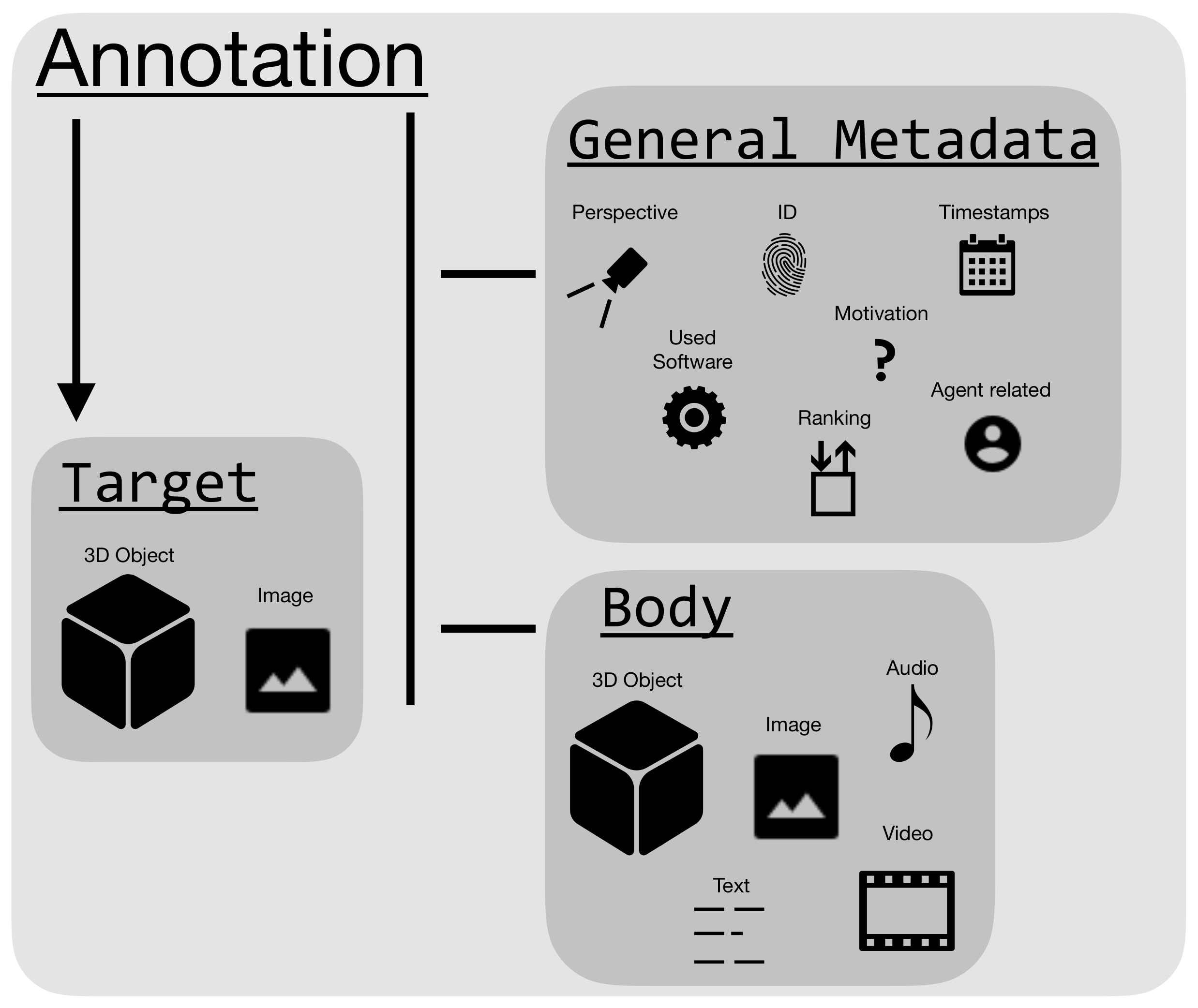1. Abstract
Annotation is a well established method in digital humanities. For textual documents, inline (typically TEI-XML) and stand-off (e.g. character index table based) markup are two widely used approaches. For adding textual annotations, various software affording different types and levels of abstraction are used, including XML editors such as Oxygen [1] as well as online systems such as Catma [2]. Many annotation systems enable annotation of other media than verbal text in various ways, often with a focus on images and figures. Systems are also available for audio annotation of text and music, and for video annotations [3].
Annotation systems for 3D models are less common and many users in the humanities and cultural heritage resort to online platforms such as Sketchfab [4]. Commercial platforms might be a good choice in many cases, but copyright issues and legal obligations make them unwanted or unusable in other. Furthermore, with these 3D presentation platforms [5], the focus is not on (collaborative) annotation as a method. Since 2017, the Departments for Digital Humanities and Media Culture and Theatre at the University of Cologne, in cooperation with the university’s Theatre Collection, has developed Kompakkt [6], a free online tool [7] for multi-modal 3D annotations which is specifically designed for collaborative work and storytelling. Kompakkt is fully open source [8] and opt for new ways to provide public access for cultural heritage objects, archival material, etc.
 Figure 1: A schematic representation of annotations in Kompakkt [9]
Figure 1: A schematic representation of annotations in Kompakkt [9]
With Kompakkt, the 3D representation of an object serves as the hub of an open-ended collection of heterogeneous information established through the use of multimodal annotations, cf. Figure 1. Through personalised and group level collections of digital objects, Kompakkt enables a novel solution for gathering, generating and inter-connecting information about digital objects and related non-digital things. Registered users may decide if their content is restricted, private or public to control the visibility and access to their objects.
Through opening up for collaborative annotation of objects, multi-vocal voices can be heard, presenting traditional scholarly and cultural heritage management perspectives as well as knowledge based on citizen humanities. Diverse groups around the world can annotate, discuss, and tell multiple stories about collections of objects, making sets of open data available to be discussed, further developed, and experienced [10].
The annotation functionality for images and 3D models enables linking between repository-internal objects and external information through weblinks. Therefore every single point on the surface of the mesh can be selected. An annotation is not only linked to a specific location in space, it also includes and covers a user defined related perspective, the corresponding point of view. Multiple Annotations in Kompakkt are chained in flexible series what allows users to walk through the different related, thereby enabling a camera track by stepping from one annotation to the next and its corresponding perspective. Consequently, presentations and storytelling can be implemented through a series of annotations traversing through different objects.
The challenge posed by the future of Kompakkt is primarily to increase the community and scale up the number of available objects. Therefore it is not only important to ensure the quality of the data through curation but also to develop the import and export functionality further and in general to enhance the usability with the help of user feedback. Additionally with the feedback from the community from the prototyping phase helps to improve and expand the annotation functionality and implement new suggested features.
References
[1] Oxygen XML Editor - The Complete Solution for XML Authoring, Development & Collaboration,
[2] CATMA – For Undogmatic Textual Markup And Analysis,
[3] For instance: Praat: Doing Phonetics By Computer,
[4] Sketchfab - Publish & Find 3D Models Online,
[5] See also: 3DHOP,
[6] An online version for testing Kompakkt is available from:
[7] Based on Web Technologies: Babylon.Js,
[8] The source code is available on Github; DH-Cologne/Kompakkt,
[9] The underlying data model is based on the W3C Recommendation Web Annotation Data Model,
[10] To that end, Kompakktnot only allows the export of the according metadata and annotations of a given object, but also is able to pull and use data from Europeana Collections to encourage interoperability.